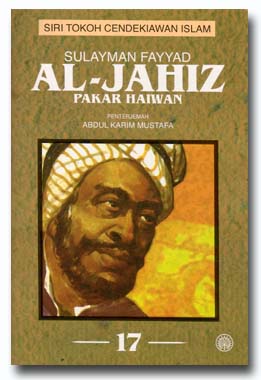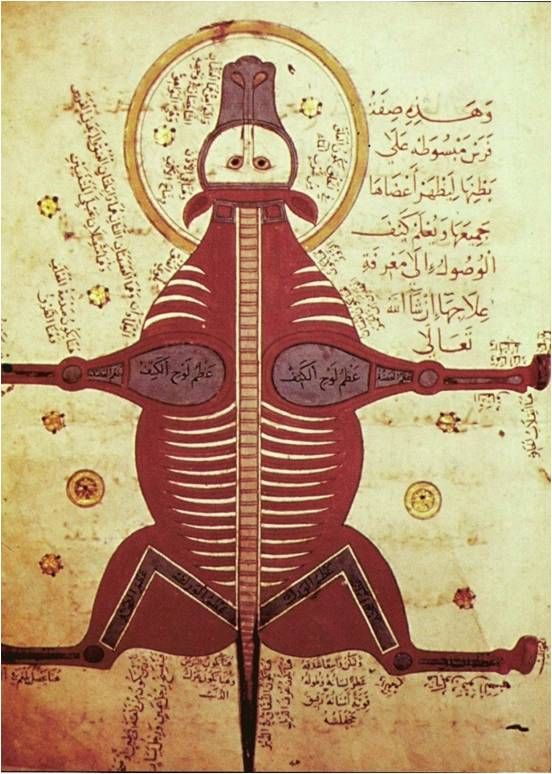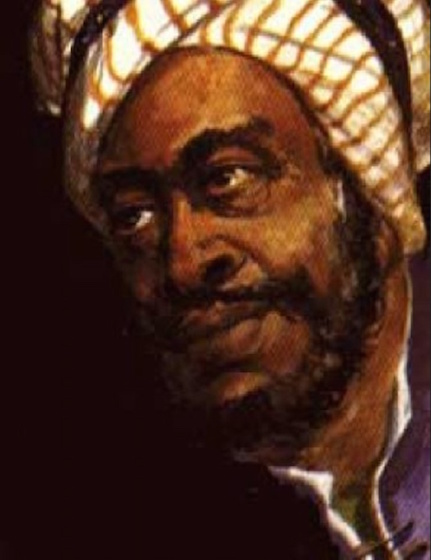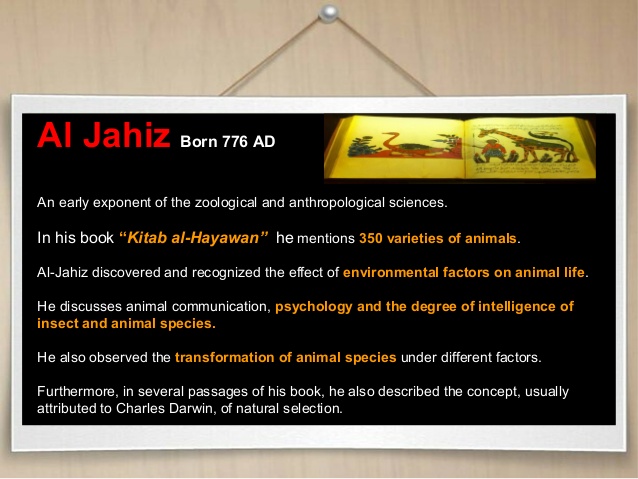|
Lazy eyes listen
|
- al-Jahiz described three mechanisms of evolution. These are, Struggle for Existence, Transformation of species into each other, and Environmental Factors
Al-Jahiz And The Rise Of Biological Evolutionism
by Mehmet Bayrakdar, 1983
Although al-Nazzam made the first steps in the field of biological evolutionary thought in the history of science, for the first time the theory of biological evolution in its complete form was presented by a great early zoologist, al-Jahiz in the ninth century. He was the first to originate it. Al-Jahiz’s theory is an example of scientific revolution and innovation that has had reverberations into the farthest reaches of human thought. It is fair to say that many problems of the philosophy of Nature appeared in a new light after the revolution of al-Jahiz and his successors. Before describing al-Jahiz’s own views and his influence upon Muslim and European thinkers, especially upon Lamarck and Darwin, I want to give some biographical and bibliographical accounts.
a. Biographical and Bibliographical Notices
Al-Jahiz’s complete name is Abu ‘Uthman Amr bin Bahr al-Fukaymi al- Basri. He owes his sobriquet (al-Jahiz = the goggle-eyed) to a malformation of his eyes. He was born at Basra about 776. Little is known of his childhood, except that, from an early age, an invincible desire for learning and a remarkably inquisitive mind urged him towards a life of independence and, much to his family’s despair, idleness. Mixing with groups which gathered at different mosques to learn, attending as a spectator the philological enquiries conducted on the Mirbad and following lectures by the most learned men and scholars of his time on philology, lexiography and poetry, namely al-Asma’i, Abu ‘Ubayda, Abu Zayd, he soon acquired real mastery of the Arabic language along with the usual and traditional culture.”1″ And later his precious intelligence won him admittance to Mu’tazili circles and bourgeois salons, where conversation, often light, was also animated by philosophical, theological, scientific problems. His penetrating observation of the various elements in a mixed population increased his knowledge of human nature, whilst reading books of all kinds which were beginning to circulate in Basra gave him some outlook onto the outside world. His early literary activity won him the compliments of al-Ma’mun and thereby that consecration by the capital coveted by so many provincials eager to have their talent recognized and so reach the court and establish themselves.
From then on, without completely abandoning Basra, al-Jahiz frequently stayed for long periods in Baghdad and later in Samarra, devoting himself to literary and scientific works. For some time he was the teacher of al-Mutawakkil’s children. Although information about his private and public life is not readily forthcoming from either his biographer or himself, it appears from what knowledge we have that al-Jahiz held no official post and took on no regular employment. He admits, however, that he received considerable sums for the dedications of his books and we know that for a time at least, he was made an allowance by the diwan.
In Baghdad, later on, he found a rich store of learning which enabled him to broaden his outlook and perfect his own philosophical and theological doctrine, which he had begun to elaborate under the supervision of the great mu tazalis of the day, of whom al-Nazzarn and Thumana b. Ashras, who seems to have had a strong influence on him, should be placed in the first rank.
Towards the end of his life, suffering from hemiplegia, he retired to his hometown, where he died in 869 (225) “2”.
As in politics, so in theology al-Jahiz was a mu’tazili. He was also a famous Muslim prose writer. His place in the development of Muslim thought is far from negligible. He was the founder of a sect named after him, al-Jahiziyya “3”. He was a genius in the science of zoology. And he knew how to obtain ammonia and salmiac from animal offals by dry distillation “4”.
Quran 29:20 Say (O Muhammad): Travel in the land and see how He originated creation, then Allah bringeth forth the later creation. Lo! Allah is Able to do all things.
Being a polyhistor and man of letters, al-Jahiz had a very great output like many Muslim writers. A catalogue of his works lists nearly 200 titles of which only about a third have been preserved in their entirety; about fifty thers have been partially preserved, whilst the rest seem irremediably lost “5”. His most important book is The Book of Animals (Kitab al-Hayawan) “6”. Iahiz’s method was empirical and scientific, not only discursive, as Sarton elieves “7”. That is why Asin Palacios says, “Como el mismo lo insinua en el rologo (I, 6), puso a contribucion para redactarlo los libros de los filosofos, os relatos y noticias de viajeros, marinos, etc. Y Ia observacion o experiencia lirecta.” The scientific value of this book is great; and it is “8”, as Asin Palacios ays, a real contribution to the history of science, namely to zoology. The main source of al-Jahiz’s Book of Animals is the book on zoology of his )recursors and contemporary, ‘Abd al-Malik bin Qurayb al-Asma’i (739- 831) “9”. As far as I knowm this book is the first zoological, book in the history of slamic thought. The Kitab al-Hayawan was the object of many studies, and had great influence upon later Muslim scientists, and via them upon European thinkers as well. And it became the source for later books on oology. Al-Jahiz’s many sentences are quoted by Ikhwan al-Safa’ and Ibn
Miskawayh, and many passages are quoted by Zakariyya’ al-Qazwini (1203-1282) in his ‘A/a’ ib al-Maklzluqat, and by Mustawfial-Qazwini (1281- ?) in his Nuzkat ai-Qulub; and al-Damiri in his Hayat al-Hayawan’ “10”.
b. Al-Jahiz’s View on Biological Evolution
After a long study of animals, Al-Jahiz was the first to put forward his view of biological evolution in his Book of Animals, which contains the germs of many later evolutionary theories (animal embryology, evolution, adaptation, animal psychology and sociology) “11”.

An early exponent of the zoological and anthropological sciences, al- Jahiz discovered and recognized the effect of environmental factors on animal life; and he also observed the transformation of animal species under different factors. And in many remarkable passages of his book, he also described for us the struggle of existences for survival, its aim and mechanisms and value in a scientific way, as well as in a folkloric way. As to know the mechanistics of evolution, al-Jahiz described three mechanisms. These are Struggle for Existence, Transformation of species into each other, and Environmental Factors.
Let us now see the mechanisms, as briefly as possible
Struggle for Existence: al-Jahiz placed the greatest weight on evolution by the struggle for existence, or, in a larger sense, by natural selection. It operates in conjunction with the innate desire for conservation and permanence of the ego. According to al-Jahiz, between every individual existence, there is a natural war for life. The existence are in struggle with each other.
Al-Jahiz’s theory of struggle for existence may accordingly be defined as a differential death rate between two variant class of existence, the lesser death rate characterizing the better adapted and stronger class. And for al-Jahiz, the struggle for existence is a divine law; God makes food for some bodies out of some other bodies’ death. He says, “The rat goes out for collecting his food, and it searches and seizes them. It eats some other inferior animals, like small animals and small birds. . . it hides its babies in disguised underground tunnels for protecting them and himself against the attack of the snakes and of the birds. Snakes like eating rats very much. As for the snakes, they defend themselves from the danger of the beavers and hyenas; which are more powerful than themselves. The hyena can frighten the fox, and the latter frightens all the animals which are inferior to it. This is the law that some existences are the food for others. . . . All small animals eat smaller ones; and all big animals cannot eat bigger ones. Men with each other are like animals. . . God makes cause of some bodies life, “ “13” from some bodies death and vice versa. And according to al-Jahiz, the struggle does not exist only between the members of different species, but also between the members of the same species “14”.
From what al-Jahiz has said, we can make an assertion that God has created Nature in a prodigal reproductive character and He has also established a law, which is the biological struggle for existence in order to keep it within a limited ratio. Otherwise, the disorder could appear in Nature and it could lose some of its riches and species. We can see the germs of Darwin’s and the Neo-Darwinian’s theory of Natural Selection in this remarkable passage which we have mentioned above. Transformation of Species: Al-Jahiz, as later Lamarck and Darwin, for example, believes that the transformation of species and mutation is possible. The transformation operates in conjunction with the effect of environmental factors. And he asserted that the original forms branched out into new forms of species by gradually developing new characteristics which helped them to survive environmental conditions. He says, “People said different things about the existence of al-miskh (the original form of quadrupeds) “15”. Some accepted its evolution and said that it gave existence to dog, wolf, fox and their similars. The members of this family came from this form (al-miskk)” “16”.
And, he adds that God’s will and power is the main causal factor in the transformation, and God can transform any species into another at any time He wants. So al-Jahiz defends the transformation of species and mutation, due to different factors, including God’s will’7, as we have said above. Here al-Jahiz got some of his material from the sayings of different learned men. As for the effect of environmental factors on species, al-Jahiz believes that the food, climate, shelter and other factors have some biological and psychological effects on species. And for him, these factors also lead the species to a hard struggle for survival. In a changed environment, there is also a change in some characters having survival value. The process of changing characters in succeeding generations makes the organisms better adapted to their environment. They thus survive and get a chance to breed and transmit their characteristics to their offspring. So, al-Jahiz based his theory upon the notion of the use and disuse of organs in the adaptation of animals to their environment.
Al-Jahiz says, “Without doubt, we have seen that some Nabatheen navigators resembled the ape in some geographical environment, likely we have also seen some people from Morocco and have found them as like as al-maskh “18”, except for a little difference…. And it is possible that the polluted air and water, and dust made this change in the character of these Moroccans. . . . If this effect goes on more and more in them, those changes in their bristles, ears, colours, and form (similar to the ape) increase more…. “ “19”
Such are the main mechanisms of al-Jahiz’s biological evolution. Now, I will speak about al-Jahiz’s great influence upon Muslim and European scientists. Al-Jahiz’s zoology and theory of biological evolution have profoundly affected the development of zoology and biology. As we have said before, al-Jahiz’s biological evolution had some direct influences upon Ikhwan al-Safa, and other illustrious philosophers, such as Ibn Miskawayh, al-Biruni, Ibn Tufayl, with whom al-Jahiz’s theory acquired a new sense, in that they made of it two new doctrines: a cosmological one, because it was applied to the phenomena of the whole universe; and a sociological one, because it was applied to social phenomena. Moreover, Ibn Miskawayh and Ibn Khaldun explain the true meaning of Prophecy and prove it by such a theory. Thus, Jahiz’s pure biological evolution became the source of different doctrines in later Islamic thought, such as sociological, metaphysical and cosmological evolutionisms.

On the other hand, al-Jahiz’s theory has been repeated by Muslim zoologists and naturalists, especially by al-Zakariyya’ al-Qazwini, in his ‘Aja’ ib al-Makhluqat, Mustawfi al-Qazwini in his Nuzhat al-Qulub, and al- Damiri in his Hayat al-Hayawan, without mentioning other literary persons, such as al-Masudi and Ibn Qutayba.
Influence Of Al-Jahiz’s Works On European Scientists

As for the influence of al-Jahiz on European thinkers, it has become the subject of two main studies: “Der Darwinismus im X und XIX Jahrhundert” of Fr. Dieterici (Leipzig, 1878) and “Darwinistisches bei Gahiz” of E. Wiedemann (sitzungsbericht der physikalisch-medizinischen Sozietaet in Erlangen, 47, 1915). Previous to me, they found a great similarity between al-Jahiz and Darwin. Indeed, Darwin and his precursors took up the theory of al-Jahiz as the base for the essentiality of their evolutionary theories, and they formulated it in a more scientific way in the context of eighteenth and nineteenth centuries development of science. Perhaps the only main difference between al-Jahiz’s theory and modern theory is in ideology: al-Jahiz’s theory is theologic and more transcendental in this sense that he accepts that the first cause of evolution in living organisms is God and that the other factors are secondary; while Lamarck, Darwin and others’ evolution is more immanent and materialistic. Although the mechanistic explanations of the theories are more or less the same, Darwin and other modern scientists differ from al-Jahiz and other Muslim writers in ideological interpretation of the theory.
Though a great majority of people, regardless of their religion, consider Darwin as the originator of the idea of evolution, Shanavas reminds us that Darwin (1809-1882) and his grandfather Erasmus Darwin were influenced by the work of Muslim scientists who lived centuries before them. For instance, Dr. Shanavas quotes from John William Draper (1812-1883), first president of American Chemical Society, a contemporary of Darwin, and a former president of New York University summarizes the deliberately induced academic amnesia in the West. Draper acknowledges the fact that Muslims described the theory of evolution in their schools centuries before the West did:
“I have to deplore the systematic manner in which the literature of Europe has contrived to put out of sight our scientific obligations to the Muhammadans. Surely they cannot be much longer hidden. Injustice founded on religious rancor and national conceit cannot be perpetuated forever.”(Draper, John William. The Intellectual Development of Europe, p. 42.) *please refer to full article @ http://www.19.org/books/islamic-theory-of-evolution-shanavas/)
Read more: https://newsrescue.com/muslim-quran-predate-darwin-evolution-theory/#ixzz4HzNz97SW
How Was Jahiz’s idea transmitted to the Europeans?
Al-Jahiz and other evolutionist Muslim thinkers influenced Darwin and his predecessors in several ways. Before the flourishing of C. Linnaeus (1707-1778), Buffon (1707-1788), E. Darwin (1731-1802),J. B. Lamarck (1744-1829), and Ch. Darwin (1809-1882), and long before the rise of the school of Natural Philosophy in Germany, al-Jahiz and others were known to Europeans through the translation of their own works and studies on them by Europeans. For example, al-Damiri’s book Hayat al-Hayawan was partially translated into Latin by a Jew, called Abraham Echellensis (d. Italy 1664) and published in Paris in 1617. This book contains many passages taken from al-Jahiz’s Kitab al-Hayawan. Al-Nuwayri’s JVihaya was studied by D’Herbelot (1625—1695) in his Bibliotheca Orientalis, and later byJ. Heyman (?—1737). Ibn Tufayl’s Hay Ibn raqzan, which contains the philosophy of evolution, was first published by Edward Pocockes, Sr. (1604-1690), together with a Latin translation published by Edward ~Pococke, Jr. (1648-1727) in Oxford in 1671 (second edition, Oxford, 1700) “20”.
Zakariyya’ al-Qazwini’s cosmography, ‘Aja’ ib al-Makhluqat was published by F. Wustenfeld in 2 volumes in Gottingen in 1848-49; and Kitab Talkhis al-A thar of Bakuwi, a summary of al-Qazwini’s book was translated into French and published by De Guignes in Paris, in 1789 “21”. In fact, his book also contains many ideas from al-Jahiz. And A. L. de Chezy translated al-Qazwini’ s ‘Aja’ib, and his translation was published in 1806 (first publication) by S. de Sacy, in his Chresiomathie A rabe. There is no doubt that the great evolutionist sufi, Mawlana, had already influenced Goethe, who called him “a Darwinian before Darwin” “22” his theory of metamorphosis has profoundly affected the development of biology. In any case, Islamic zoology penetrated the West as early as the seventeenth century “23”. Some Europeans knew Arabic and they could read directly from the Muslim scientists’ books; for example, Darwin was himself initiated into Islamic culture in Cambridge under a jewish orientalist called Samuel Lee “24”. We think that what we have said can show Muslim influence upon Europeans. Some further comparative study can be undertaken in this subject, in order to bring to light the influence of Muslim evolutionist thinkers upon the Europeans and the transmission of their ideas to the West.
Al-Jahiz’s theory of evolution was something very new in the history of science, and there was nothing written previous to it. Although Greek philosophers like Empedocles and Aristotle spoke of the change in Nature, in plants and animals, they never made the first steps on the field of the future theory of evolution of the Muslims. Their concept of change was only a concept of simple change and motion, nothing more than that. And by the concept of change, they never designed explicitly or implicitly a concept of evolution: “The World of Nature is thus for Aristotle, a world of self-moving thing, as it is for the Ionians and for Plato. Nature as such is process, growth, change. This process is a development, i.e. the changing takes successive forms, a, b, y, . . . in which each is the potentiality of its successor, but it is not what we call ‘evolution’, because for Aristotle, the kinds of change and of structure exhibited in the world of nature form an eternal repertory, and the items in the repertory are related logically, not temporally, among themselves”25″”.
References
1) Pellat (Ch.), “Al-Dlahiz”, in RI2, vol. II, p. 385.
2) Ibn ‘Asakir, MMIJ, IX, pp. 203—217.
3) Khaiib Baghdadi, XII, pp. 212-222.
4) Sarton (G.), Iniroduciion in ihe Hisiorp of Science, vol. I, Washington, 1927, p. 597.
5) Pellat (Ch.), “Gahiziana”, in Arabica, 1956/2; cf Brockelmann (C.), GAL, SI., 241ff
6) The Book of .4niinals was published in 7 volumes, in Cairo, 1323—1324.
7) Sarton says: “His most important work is The Book oj.-Inimals, a very discursive compilation, the purpose of which is theological and folkloric, rather than scientific , Sarton, op. cii., p. 597. Sarton’sjudgement is not true; indeed, many of the knowledges given in the 1)00k are the result of his personal observation and his experiences, as al-Jahiz himself says in several chapters.
8) Asin Palacios (M.), “El ‘Libro de los Animales’ deJahiz”, in isi.’;, vol. 14 1930, p. 21.
9) Some parts of’ his book are published by R. Geyer in Wien, in 1887; and by A. Haffner in Wien, in 1895—1896; the book on the creation of man is still unpublished.
10) It is very interesting to notice that a summary of’ al-Damiri’s and other Muslim scientists’ books was translated into Latin by Abraham Echellensis (d. Italy 1664) and was published under the title “Dc Proprietatibus et Virtutibus Medicis Animalium” in Paris, in 1617. So, that is to say, sometime before the appearance ofbarwin’s precursors, such as F. Redi (1626—1698), C. Linnaeus (1707—1778), Buflon (1707—1788), Lamarck (1744—1829). the idea of evolution of Muslims was penetrated in West and this explains why the first evolutionists came from France. See Mieli (A.), La Science .1 robe ei Son Role dan l’Et’oluiion Scienijfique Mondiale, Leiden, Brill, 1938, pp. 263-264, n. 3; and extracts have been translated into French by A.J. Silvestre dc Sacy, Oppianos II, Strasbourg, 1787; see Sarton (G.), Vol. III, Part II, p. 1641. 11) Pella (Ch.), ‘Al-Djahiz”, op. cii., p. 386; cf Sarton, op. cii., p. 597.
12) Al-Jahiz, Kiiab al-Ha vawan, Vol. I, Cairo, 1909, p. 13, and see also different chapters of the volumes.
13) ldem., Vol. VI, pp. 133—34; and there are many passages in different volumes illustrating the struggle for existence. See VI, 139; VII, 47, 80. 14. ldem., vol. VII, pp. 47-48.
15) According to some opinions, this original form of animal was lost because of earthquakes and floods. See al-Jahiz, op. cit., vol. IV, p. 24; cf vol. VII, p. 77.
16) ldem, vol. IV, p. 23.
17) ldem., vol. IV, pp. 24-25; c1 vol. VI, pp. 24-26.
18) I think al-Maskh is a kind of ape; see Vol. IV, p. 24. And do not confuse al-Maskh with al-Miskh.
19) ldem., Vol. IV, p. 24; and cf vol. IV, pp. 25-27.
20) See Sarton (0.), op. cii., vol. II, Part 2, pp. 354—355.
21) Mieli (A.), op. cii., p. 152.
22) Cassirer (E.), The Problem of Knowledge, translated by W. H. Woglom and Ch. W. Hendel, Yale University Press, New Haven, 1950, p. 137.
23) Sarton (G.), op. cii., vol. III, part 2, p. 1641.
24) See Darwin (Sir F.), The Life and Letters of’ Charles Darwin, vol. I, London, 1887, p. 289. Samuel Lee (1783-1852), of Queen’s, was professor of Arabic and Hebrew. In 1821, he issued a “Sylloge Librorum Orientalium”. In 1829, he translated “The Travel of Ibn Battuta”, see The Dictionary of National Biography, vol. XI, London, 1917, pp. 819-820.
25) Collingwood (R. C.), The Idea of’ Nature, Oxford, 1945, p. 82.
The Islamic Quarterly, London
Third Quarter 1983






